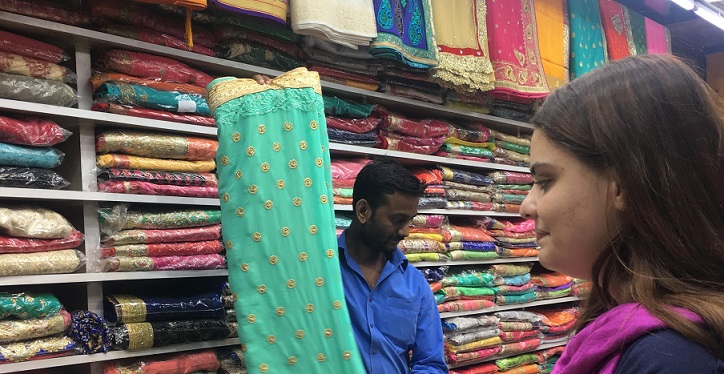By Chantal Young

Okay let’s face it – I love shopping. Throughout this field school, if there is a shop to visit I’ll be there. India provides a wealth of unique handicrafts, leather goods and beautiful textiles and I have a collection of mementos sourced from diverse locations such as entrepreneurial artisans in Dharavi slum to women’s collectives of northern India. Having worked in Australian retail throughout the duration of my undergraduate studies, I also have a degree of fascination and affinity with the shopkeepers I have met along the way.
Recently in Ranthambore, an area famous for tiger safaris, I visited a handicraft market adjacent to our hotel. Here I got talking to Ashok, the man who runs the stalls. Chatting over beautiful silks we began comparing work conditions. We both cut fabric for a living, just 10,000km apart, and it turns out that while I earn $20/hour part time, working a maximum of 10hour days, Ashok works 14hour days earning just 7000 rupees a month, or about $140. The shop was lovely, packed with fabrics and gifts, and I managed to spend nearly his month’s salary in an evening. This really drove home the issue of India’s income challenges in a very personal way.
In seminars, lectures and field visits a major theme has been wealth and poverty in India, and the vast economic inequalities. Currently, India is said to be the second most unequal country in the world, with the richest 10% of Indians owning 80% of the wealth. This trend is increasing every year, with around 30% of the population living below the poverty line.
Market liberalisation since 1991 has encouraged traditional skills and trades to engage in entrepreneurship within the capitalist market to increase income, and the results of this were evident in several of the handicraft markets we have visited throughout the trip. Many of these businesses focus on positive social change, and increasing the standards of living for the poor and marginalised. One example is Bunkaar Textiles, a rural woman’s collective weaving and embroidering scarves for sale, or Dharavi leather goods which sells bags, belts, and wallets made by leatherworkers in the Mumbai slum. While these initiatives are a great start to secure income streams for groups of people living below the poverty line, it will take larger initiatives to really transform lives across the nation through income and employment.
In 2005 the government established the National Rural Employment Guarantee, a progressive act which aims to guarantee the ‘right to work,’ and enhance livelihood security in rural areas by providing at least 100 days of wage employment per year. In 2014 the World Bank described the program as a ‘stellar example of rural development’ and it appears to be ‘slowly but surely’ making a positive difference in the lives of the rural poor. Yet the government still lacks a social welfare payments scheme which would see the unemployed or underpaid guaranteed income payments to meet basic needs. Instead, there is a complex array of subsidies and grain rations to households sitting below the poverty line. On our Ranthambore safari we did not manage to see a tiger, so Ashok gave me a tiger postcard at the store. Just like this ‘consolation prize,’ allocation of grain rations comes as a welcome but poor second to monetary welfare payments and the financial freedom that accompanies them.
The issue of how best to deal with income inequality and poverty are not isolated to India, and back in Australia we debate over the relatively low minimum wage of retail, arguing it is not enough considering the high cost of living in Sydney. But visiting India and interacting with the retail industry here has put this in perspective for me, and I am extremely grateful for the employment standards and welfare systems we do have.
As our tour guide in Dharavi said, ‘change is the only constant in India,’ and everything is changing very fast. A new middle class is burgeoning, and I look forward to the day when these inequalities in India can be reduced and Ashok does not need to work 14hour days to make ends meet. In the meantime, shopping in India certainly has been an eye opening experience speaking to many of the income issues facing the nation today.
Skip to content

